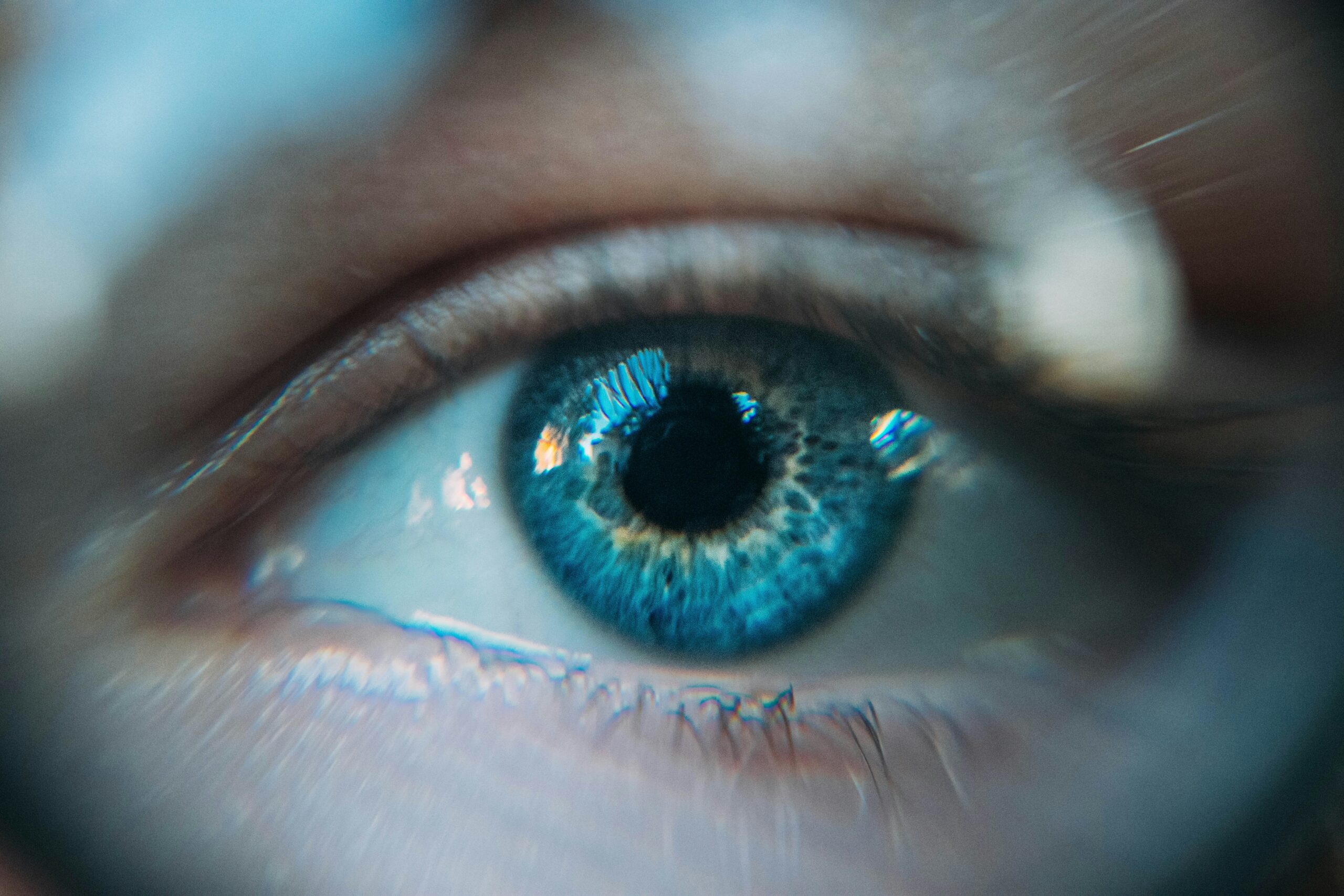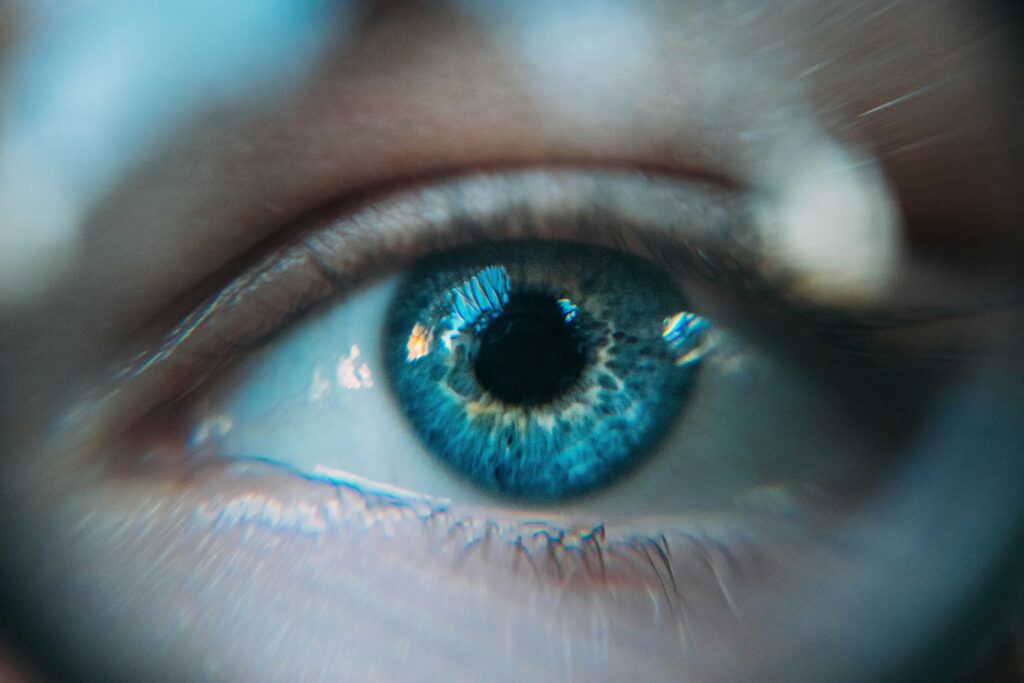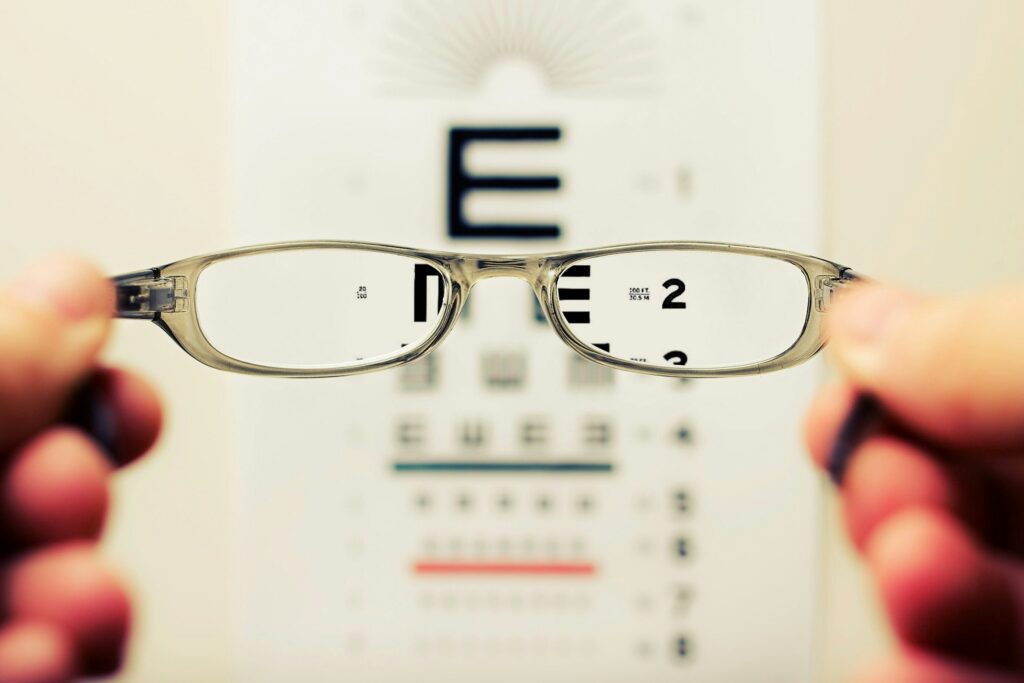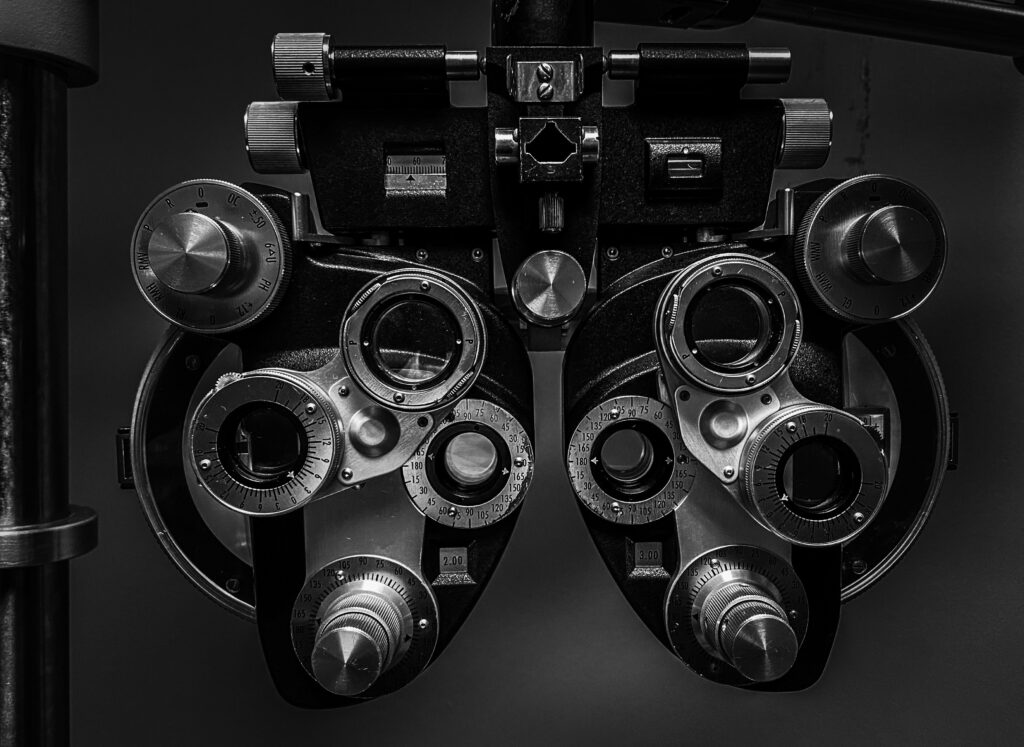Your cart is currently empty!

What You Need to Know About AMD and Low Vision This Awareness Month

Every February, AMD/Low Vision Awareness Month shines a spotlight on age-related macular degeneration (AMD) and low vision, two conditions that significantly impact the quality of life for millions of people worldwide. This month serves as a vital reminder to prioritize eye health, understand the risks, and seek timely interventions.
Did you know that AMD is the leading cause of vision loss among adults over the age of 50? In fact, more than 11 million Americans are affected by AMD, with numbers expected to double by 2050 due to an aging population. Low vision, often caused by AMD and other eye conditions, can make everyday tasks like reading, driving, and recognizing faces challenging, affecting independence and well-being.
The goal of this post is to raise awareness about AMD and low vision, highlight the importance of early detection, and provide actionable resources to help prevent or manage these conditions. By understanding the risks and taking proactive steps, we can work together to reduce the impact of vision loss and improve lives.
Understanding AMD and Low Vision
Age-related macular degeneration (AMD) is a common eye condition that affects the macula, the part of the retina responsible for sharp, central vision. AMD gradually diminishes the ability to see fine details, making activities like reading, driving, and recognizing faces increasingly difficult. It primarily affects adults aged 50 and older and is a leading cause of vision loss worldwide.
There are two main types of AMD:
- Dry AMD
- The most common form, accounting for about 85–90% of cases.
- Caused by the thinning of the macula and the accumulation of small yellow deposits called drusen.
- Progresses slowly and can lead to gradual vision loss over time.
- Wet AMD
- A less common but more severe form.
- Occurs when abnormal blood vessels grow under the retina and leak fluid or blood, causing rapid and significant vision loss.
- Requires immediate medical attention to prevent further damage.
What Is Low Vision?
Low vision refers to a significant visual impairment that cannot be corrected with standard eyeglasses, contact lenses, medications, or surgery. It impacts everyday activities and reduces independence but does not result in complete blindness.
Key differences between low vision and regular vision impairment:
- Regular vision impairment, such as nearsightedness, can typically be corrected with glasses or contacts.
- Low vision requires specialized tools like magnifiers, adaptive technology, or vision rehabilitation services to assist with daily tasks.
How Does AMD Contribute to Low Vision?
AMD is one of the primary causes of low vision in older adults. As the macula deteriorates, individuals may experience:
- Blurred or distorted central vision, making it difficult to read or recognize faces.
- A dark or empty area in the center of their vision.
- Challenges with tasks requiring precision, such as sewing or cooking.
The progressive nature of AMD can lead to a significant decline in quality of life. It often affects emotional well-being as individuals adjust to the limitations of vision loss.
Living with AMD and low vision can make even simple tasks feel overwhelming. Activities like navigating stairs, preparing meals, or enjoying hobbies may require adjustments. However, with early diagnosis, adaptive tools, and proper support, many individuals can maintain a fulfilling and independent lifestyle.
Signs and Symptoms
Recognizing the symptoms of age-related macular degeneration (AMD) and low vision is crucial for early intervention. Identifying these signs early can significantly improve the chances of managing the condition and preserving quality of life.
Common Symptoms of AMD
- Blurred or Distorted Central Vision
- Straight lines may appear wavy or bent, and objects may seem distorted.
- Activities like reading or watching TV become more challenging due to unclear details.
- Difficulty Reading
- Small print becomes harder to read, even with corrective lenses.
- Increased reliance on magnifying tools or large-print materials.
- Trouble Recognizing Faces
- Difficulty identifying people’s faces, especially from a distance, can affect social interactions.
- Dark or Empty Spots in Vision
- A noticeable dark or empty area may appear in the center of vision, particularly in advanced stages.
- Reduced Brightness or Color Perception
- Colors may seem duller, and contrast between objects becomes harder to distinguish.
Symptoms of Low Vision
- Reduced Visual Field
- Individuals may experience tunnel vision, where peripheral vision is significantly limited.
- Difficulty seeing objects outside the central visual area, impacting navigation and mobility.
- Challenges with Contrast and Light Sensitivity
- Struggling to distinguish objects from their background, particularly in dim lighting or areas with glare.
- Increased difficulty transitioning between light and dark environments.
- Loss of Depth Perception
- Problems judging distances can make tasks like pouring liquids, climbing stairs, or driving unsafe.
The Impact on Everyday Tasks
- Mobility: Navigating through crowded spaces or unfamiliar areas becomes harder due to reduced vision.
- Daily Activities: Reading labels, cooking, or using electronic devices often requires adaptive tools.
- Emotional Well-Being: Vision loss can lead to frustration, reduced independence, and feelings of isolation.
Timely detection of AMD and low vision symptoms is critical. Early intervention can:
- Slow disease progression with treatments like medications, lifestyle changes, or surgery.
- Help individuals adapt to changes with vision rehabilitation services and assistive technology.
- Preserve independence and improve overall quality of life.
If you or a loved one notices changes in vision, don’t delay scheduling an eye exam. Proactive care can make all the difference in managing these conditions.

Risk Factors and Causes
Understanding the factors that contribute to age-related macular degeneration (AMD) and low vision is crucial for identifying individuals at higher risk and taking preventative measures. While some risks are beyond our control, others can be managed through lifestyle changes and medical care.
Key Factors Contributing to AMD and Low Vision
- Aging
- Aging is the primary risk factor for AMD and low vision, with individuals over 50 being most affected.
- As the eyes age, the macula and other structures in the eye become more vulnerable to damage.
- Genetics
- A family history of AMD significantly increases the likelihood of developing the condition.
- Certain genetic mutations are linked to a higher risk, making regular eye exams essential for those with a family history.
- Lifestyle Choices
- Smoking: Smokers are up to four times more likely to develop AMD compared to non-smokers. Smoking damages blood vessels in the eyes and accelerates degeneration.
- Obesity: Being overweight increases the risk of AMD progression to advanced stages.
- Prolonged Sun Exposure: Chronic exposure to ultraviolet (UV) rays can damage the retina and increase the risk of AMD. Wearing sunglasses with UV protection is vital.
Chronic Conditions and Eye Health
- Diabetes
- Diabetes is a leading cause of vision loss and blindness due to its impact on blood vessels in the eyes.
- Diabetic retinopathy can exacerbate low vision and increase the risk of developing AMD.
- Controlling blood sugar levels through diet, exercise, and medication can reduce these risks.
- Cardiovascular Disease
- High blood pressure and high cholesterol can reduce blood flow to the retina, contributing to AMD development.
- Managing heart health is a critical component of eye care.
- Other Chronic Conditions
- Autoimmune diseases, chronic kidney disease, and inflammatory disorders can also affect eye health and increase the risk of vision impairment.
Reducing Risk Through Preventative Measures
While some risk factors, such as aging and genetics, cannot be changed, others can be addressed through proactive steps:
- Quit Smoking: Reducing or eliminating tobacco use lowers the risk of AMD and improves overall health.
- Maintain a Healthy Weight: Adopt a balanced diet and regular exercise routine to reduce the risk of obesity-related vision problems.
- Protect Your Eyes: Wear sunglasses with UV protection and avoid direct exposure to harmful sunlight.
- Manage Chronic Conditions: Regular medical check-ups and proper management of diabetes, hypertension, and cholesterol can protect your vision.
By understanding the factors contributing to AMD and low vision, you can make informed decisions to safeguard your eye health. Regular eye exams and healthy lifestyle choices remain the best defense against these conditions.
Prevention and Early Detection
Taking proactive steps to protect your vision is essential for preventing age-related macular degeneration (AMD) and low vision. Simple lifestyle changes and regular eye care can significantly reduce the risk and detect issues early, offering the best chance to preserve your sight.
Tips for Maintaining Eye Health
- Adopt a Nutrient-Rich Diet
- Include foods high in antioxidants, such as leafy greens (spinach, kale) and colorful vegetables (carrots, sweet potatoes).
- Consume omega-3 fatty acids found in fatty fish like salmon or walnuts to support overall eye health.
- Incorporate lutein and zeaxanthin-rich foods, such as eggs and corn, to protect the macula.
- Limit processed foods and sugar, which can contribute to chronic diseases affecting vision.
- Engage in Regular Exercise
- Physical activity improves blood circulation, which is vital for delivering oxygen and nutrients to the eyes.
- Aim for at least 30 minutes of moderate activity (like walking, cycling, or yoga) most days of the week.
- Protect Your Eyes from Harmful UV Rays
- Wear sunglasses with 100% UV protection to shield your eyes from damaging ultraviolet rays.
- Consider wide-brimmed hats for additional protection on sunny days.
- Quit Smoking
- Smoking accelerates macular degeneration and damages blood vessels in the eyes. Quitting smoking is one of the most impactful steps for preventing AMD.
The Importance of Routine Eye Exams
Regular eye exams are critical for detecting AMD and other vision issues in their earliest stages. Early detection allows for timely intervention, potentially slowing progression and preserving sight.
- Frequency:
- Adults over 40 should have an eye exam every 2–4 years.
- After age 65, exams should be conducted every 1–2 years.
- Individuals with risk factors, such as a family history of AMD or diabetes, may need more frequent screenings.
- Eye exams can detect early signs of AMD, glaucoma, diabetic retinopathy, and other conditions before noticeable symptoms arise.
Advancements in Diagnostic Tools for AMD and Low Vision
- Optical Coherence Tomography (OCT)
- Provides detailed cross-sectional images of the retina, helping detect macular degeneration and monitor changes over time.
- Fundus Photography
- Captures high-resolution images of the retina, allowing doctors to detect abnormalities like drusen or retinal changes.
- Amsler Grid Test
- A simple yet effective tool for identifying visual distortions or blind spots, often an early sign of AMD.
- Genetic Testing
- Available for individuals with a family history of AMD to assess genetic risk and guide preventative care.
By maintaining a healthy lifestyle, protecting your eyes, and staying on top of routine check-ups, you can significantly reduce your risk of AMD and other vision issues. Combining preventative measures with the latest diagnostic tools ensures that your eye health is well-protected for years to come.
Resources and Support
Living with age-related macular degeneration (AMD) or low vision can be challenging, but a wide range of resources, organizations, and communities are available to provide guidance and support. These trusted sources offer valuable information, emotional support, and tools to help individuals and caregivers navigate life with vision loss.
Key Organizations and Helplines
- American Academy of Ophthalmology (AAO)
- The AAO offers comprehensive resources on eye health, AMD, and low vision. Their website includes information about symptoms, treatment options, and preventative care.
- Website: www.aao.org
- National Eye Institute (NEI)
- A leading authority on vision research, the NEI provides educational materials, research updates, and practical tips for managing AMD and low vision.
- Website: www.nei.nih.gov
- Prevent Blindness
- This nonprofit organization focuses on preventing blindness and preserving sight through education, advocacy, and community-based programs.
- Website: www.preventblindness.org
- Helpline: 1-800-331-2020
- Macular Degeneration Association (MDA)
- The MDA offers support and education to individuals diagnosed with AMD, including webinars, newsletters, and local support group connections.
- Website: www.macularhope.org
- VisionAware
- A resource from the American Printing House for the Blind, VisionAware provides practical advice, tips, and emotional support for individuals adjusting to vision loss.
- Website: www.visionaware.org

Online Communities and Support Groups
- AMD Support Facebook Group
- A peer-led group where individuals with AMD share experiences, advice, and encouragement.
- Vision Loss Resources Community Forum
- An online space for discussing challenges and solutions related to low vision, with contributions from both patients and experts.
- The Foundation Fighting Blindness Forums
- A platform for connecting with others affected by AMD or similar conditions, offering a space to exchange stories and coping strategies.
- Website: www.fightingblindness.org
Reputable Resources for Further Guidance
- BrightFocus Foundation
- Provides research updates, educational materials, and support resources for AMD and other vision-related diseases.
- Website: www.brightfocus.org
- Hadley Institute for the Blind and Visually Impaired
- Offers free workshops, tutorials, and videos to help individuals with vision loss adapt to daily challenges.
- Website: www.hadley.edu
- Lighthouse Guild
- Specializes in vision and healthcare services, offering tele-support groups, vision rehabilitation, and adaptive technology programs.
- Website: www.lighthouseguild.org
These resources ensure that individuals with AMD or low vision, as well as their caregivers, have access to the tools, education, and emotional support they need. By connecting with these organizations and communities, you can navigate the challenges of vision loss and maintain a fulfilling and independent lifestyle.
AMD/Low Vision Awareness Month serves as an important reminder of the steps we can take to protect our vision and support those affected by AMD and low vision. From understanding the risk factors and symptoms to adopting preventative measures and leveraging advancements in diagnostics, awareness is key to preserving eye health and enhancing quality of life.
You can significantly reduce your risk of vision loss by making small, proactive changes—like maintaining a nutrient-rich diet, staying active, and scheduling regular eye exams. For those already living with AMD or low vision, there is a wealth of resources, organizations, and communities offering guidance and support to help navigate daily challenges.
Your eye health is a priority, and staying informed is the first step. Subscribe to our newsletter for expert insights, tips, and updates on AMD and other health topics. Together, we can raise awareness, foster hope, and take meaningful strides toward better vision care.

Leave a Reply